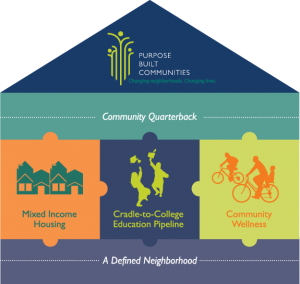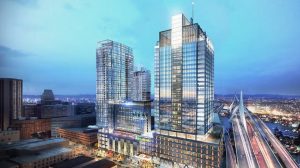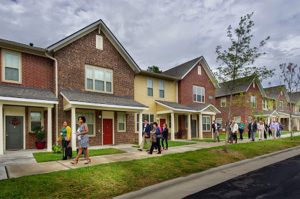|
|
Student Corner: Building up the “S”: How Municipalities and Real Estate Developers Can Find Common Ground for Social EquityBy CED Program Interns & StudentsPublished August 10, 2021
Sprawled on roughly 40 acres in Charlotte, N.C., The Renaissance is the first Purpose Built Community in the Queen City. Its purpose: be more than a housing option. Developed by Laurel Street Residential in 2016 on behalf of the Charlotte Housing Authority (Now InLivian), The Renaissance offers cradle-to-college-to-career educational curriculum and wellness programs with the aim of enhancing social equity, eradicating generational poverty and improving physical and mental health. The advancement of these goals rests with the Renaissance West Community Initiative (RWCI), which was formed to serve as the so-called community quarterback for The Renaissance, which has more than 300 rental units. “What RWCI focuses on revolves around the social determinants of health,” said Jackie Tynan, chief impact officer at RWCI. “There’s a social equity and a racial equity component to that. Overall, we focus on all things related to individual and family well-being.” Social Equity Defined by the Urban Land Institute (ULI) as “just and fair inclusion” that enables all citizens to realize their full potential, social equity often surfaces in environmental, social, and governance (ESG) evaluations of companies. Its importance has only grown during the coronavirus pandemic and the protests for racial justice that dominated 2020. Municipalities and businesses, alike, are now seeking ways to address long-standing social injustices and incentivize equitable progress. Real estate impacts social issues in intricate and inevitable ways. Building designs and materials dictate how we live and work. The private development process molds and reengineers the character of neighborhoods. Government policies and incentives broadly define the housing stock and amenities of communities across the nation – and who has access to them. Hence, racial, economic and health disparities, among other untoward differences, can percolate along property lines.  Yet, in the realm of real estate development, social equity is still not as easily understood – or quantifiable – as environmental and governance efforts are. The Renaissance, as an example of the Purpose Built Communities model, which delivers a holistic living environment based on mixed-income housing, education and wellness, is uncommon for the industry. A recent research report by ULI states that “beyond nonprofit housing developers, the real estate industry [is] relatively unaware of both how social equity relates to real estate development and what potential benefits could come from practices that support social equity.” As a result, towns can play a critical role in advancing social equity in the built environment. Yet, municipalities that seek to do so (be it through affordable apartments or retail space for local ventures) should first understand how private developers approach projects. Only then, can local governments find feasible ways (from providing funds to updating zoning requirements) to further developments with a positive social impact. The links between real estate development and social equity One reason why social equity is yet to be fully recognized as a factor for private real estate development is that it is generally hard to model financially. The costs of social programing pile upfront, while the returns are frequently elusive. Unlike energy-efficient systems, for example, that explicitly translate into operational dollars saved, a free day care in a workforce apartment complex, for instance, might not immediately and directly boost profits.  “Some things are easy to quantify,” said Giuliana DiMambro, senior project manager at developer Boston Properties. “Public realm improvements have a dollar value, affordable units have a dollar value. But then, there are also things from an urban design perspective. We’re here building a building for our tenants, but the way that building interacts with the neighborhood and with the city and with the skyline is more intangible.” A signature project for DiMambro is The Hub on Causeway in Boston. In the works for nearly a decade, The Hub on Causeway revitalized a neighborhood once disjointed by roads and rails and lacking basic amenities. The area was considered a food desert. Because getting an affordable grocery store was a top priority for local residents, Boston Properties prioritized it, too, in the massive development that includes stores, apartments, offices and a hotel. “One of the main reasons we have a supermarket at the project is because there was a strong group of residents that had been advocating to bring an affordable supermarket to the neighborhood for years,” said DiMambro. “As we thought about social impact we engaged with the community and they had some really great ideas that we were able to help make a reality.” Metrics such as proximity to food options, walkability scores, tenant retention and the number of jobs created are some of the measures ULI sees as salient when evaluating the social value of real estate projects. For instance, RWCI tracks the income of the families that participate in a self-sufficiency program available to them through the Initiative. In 2019, the latest year for which data is available, the average income of those households rose nearly 60%, from $13,100 at move-in to $22,600, according to RWCI’s annual report. The objective is to help residents “get out and stay out of poverty,” the report states. The role of public-private partnerships While some private developers and investors might emphasize such metrics when evaluating projects, real estate projects focused on social equity often tiptoe on the edge of financial feasibility. They may also struggle to conform to restrictive zoning and still generate attractive returns for investors. Thus, developments that elevate social equity frequently rely on numerous funding sources in order to become a reality. When they do materialize, they are often emblems of public-private partnerships. And, here is where local governments and public entities can step in. For instance, the result of a $100-million public-private partnership, The Renaissance received financial support from the Charlotte Housing Authority and the city of Charlotte; subsidized loans from the North Carolina Housing Finance Agency; as well as equity raised through 4% and 9% low-income housing tax credits, among other sources. Aside from partially funding them, municipalities can also advance socially focused developments through public engagement, density bonuses and property tax abatements, to name a few planning and zoning tools. In Massachusetts, housing redevelopment authorities have urban renewal powers that enable them to offer expedited zoning relief and to structure tax agreements for projects in specific underserved and blighted areas. In most cases, the profit that developers and investors can receive from such projects is capped at 8%, with excess income reinvested in the community or returned to the municipality. Through that statute, The Hub on Causeway generated tax savings for Boston Properties. In turn, the developer passed them onto the supermarket, making it possible for the store to operate in the neighborhood. “That was really important to help us bring in a mix of uses beneficial to the community,”DiMambro said. “Otherwise, a developer may seek a bank or a high-end retail that can pay higher rent.” The advancement of social equity often requires creative approaches and strong cooperation between developers, municipalities and communities. Yet, it can create advantages for all stakeholders. For private developers, an emphasis on social equity can translate into higher building occupancy and tenant retention (which result in stable cash flows), capital from ESG-minded investors as well as the activation of an area for future projects. For towns and their residents, social equity can generate better housing, health and economic outcomes. And, while correcting entrenched societal disparities is a multi-pronged and complicated process, integrating social equity goals into real estate projects can be one viable method to make progress locally. Dima Williams is a MBA candidate at the UNC-Chapel Hill Kenan-Flagerl Business School and a Community Revitalization Fellow with the Development Finance Initiative. |
Published August 10, 2021 By CED Program Interns & Students

Sprawled on roughly 40 acres in Charlotte, N.C., The Renaissance is the first Purpose Built Community in the Queen City. Its purpose: be more than a housing option. Developed by Laurel Street Residential in 2016 on behalf of the Charlotte Housing Authority (Now InLivian), The Renaissance offers cradle-to-college-to-career educational curriculum and wellness programs with the aim of enhancing social equity, eradicating generational poverty and improving physical and mental health.
The advancement of these goals rests with the Renaissance West Community Initiative (RWCI), which was formed to serve as the so-called community quarterback for The Renaissance, which has more than 300 rental units. “What RWCI focuses on revolves around the social determinants of health,” said Jackie Tynan, chief impact officer at RWCI. “There’s a social equity and a racial equity component to that. Overall, we focus on all things related to individual and family well-being.”
Social Equity
Defined by the Urban Land Institute (ULI) as “just and fair inclusion” that enables all citizens to realize their full potential, social equity often surfaces in environmental, social, and governance (ESG) evaluations of companies. Its importance has only grown during the coronavirus pandemic and the protests for racial justice that dominated 2020. Municipalities and businesses, alike, are now seeking ways to address long-standing social injustices and incentivize equitable progress.
Real estate impacts social issues in intricate and inevitable ways. Building designs and materials dictate how we live and work. The private development process molds and reengineers the character of neighborhoods. Government policies and incentives broadly define the housing stock and amenities of communities across the nation – and who has access to them. Hence, racial, economic and health disparities, among other untoward differences, can percolate along property lines.

Yet, in the realm of real estate development, social equity is still not as easily understood – or quantifiable – as environmental and governance efforts are. The Renaissance, as an example of the Purpose Built Communities model, which delivers a holistic living environment based on mixed-income housing, education and wellness, is uncommon for the industry. A recent research report by ULI states that “beyond nonprofit housing developers, the real estate industry [is] relatively unaware of both how social equity relates to real estate development and what potential benefits could come from practices that support social equity.”
As a result, towns can play a critical role in advancing social equity in the built environment. Yet, municipalities that seek to do so (be it through affordable apartments or retail space for local ventures) should first understand how private developers approach projects. Only then, can local governments find feasible ways (from providing funds to updating zoning requirements) to further developments with a positive social impact.
The links between real estate development and social equity
One reason why social equity is yet to be fully recognized as a factor for private real estate development is that it is generally hard to model financially. The costs of social programing pile upfront, while the returns are frequently elusive. Unlike energy-efficient systems, for example, that explicitly translate into operational dollars saved, a free day care in a workforce apartment complex, for instance, might not immediately and directly boost profits.

“Some things are easy to quantify,” said Giuliana DiMambro, senior project manager at developer Boston Properties. “Public realm improvements have a dollar value, affordable units have a dollar value. But then, there are also things from an urban design perspective. We’re here building a building for our tenants, but the way that building interacts with the neighborhood and with the city and with the skyline is more intangible.”
A signature project for DiMambro is The Hub on Causeway in Boston. In the works for nearly a decade, The Hub on Causeway revitalized a neighborhood once disjointed by roads and rails and lacking basic amenities. The area was considered a food desert. Because getting an affordable grocery store was a top priority for local residents, Boston Properties prioritized it, too, in the massive development that includes stores, apartments, offices and a hotel.
“One of the main reasons we have a supermarket at the project is because there was a strong group of residents that had been advocating to bring an affordable supermarket to the neighborhood for years,” said DiMambro. “As we thought about social impact we engaged with the community and they had some really great ideas that we were able to help make a reality.”
Metrics such as proximity to food options, walkability scores, tenant retention and the number of jobs created are some of the measures ULI sees as salient when evaluating the social value of real estate projects. For instance, RWCI tracks the income of the families that participate in a self-sufficiency program available to them through the Initiative. In 2019, the latest year for which data is available, the average income of those households rose nearly 60%, from $13,100 at move-in to $22,600, according to RWCI’s annual report. The objective is to help residents “get out and stay out of poverty,” the report states.
The role of public-private partnerships
While some private developers and investors might emphasize such metrics when evaluating projects, real estate projects focused on social equity often tiptoe on the edge of financial feasibility. They may also struggle to conform to restrictive zoning and still generate attractive returns for investors. Thus, developments that elevate social equity frequently rely on numerous funding sources in order to become a reality. When they do materialize, they are often emblems of public-private partnerships.
And, here is where local governments and public entities can step in. For instance, the result of a $100-million public-private partnership, The Renaissance received financial support from the Charlotte Housing Authority and the city of Charlotte; subsidized loans from the North Carolina Housing Finance Agency; as well as equity raised through 4% and 9% low-income housing tax credits, among other sources.
Aside from partially funding them, municipalities can also advance socially focused developments through public engagement, density bonuses and property tax abatements, to name a few planning and zoning tools. In Massachusetts, housing redevelopment authorities have urban renewal powers that enable them to offer expedited zoning relief and to structure tax agreements for projects in specific underserved and blighted areas. In most cases, the profit that developers and investors can receive from such projects is capped at 8%, with excess income reinvested in the community or returned to the municipality.
Through that statute, The Hub on Causeway generated tax savings for Boston Properties. In turn, the developer passed them onto the supermarket, making it possible for the store to operate in the neighborhood. “That was really important to help us bring in a mix of uses beneficial to the community,”DiMambro said. “Otherwise, a developer may seek a bank or a high-end retail that can pay higher rent.”
The advancement of social equity often requires creative approaches and strong cooperation between developers, municipalities and communities. Yet, it can create advantages for all stakeholders. For private developers, an emphasis on social equity can translate into higher building occupancy and tenant retention (which result in stable cash flows), capital from ESG-minded investors as well as the activation of an area for future projects. For towns and their residents, social equity can generate better housing, health and economic outcomes. And, while correcting entrenched societal disparities is a multi-pronged and complicated process, integrating social equity goals into real estate projects can be one viable method to make progress locally.
Dima Williams is a MBA candidate at the UNC-Chapel Hill Kenan-Flagerl Business School and a Community Revitalization Fellow with the Development Finance Initiative.
Author(s)
Tagged Under
This blog post is published and posted online by the School of Government to address issues of interest to government officials. This blog post is for educational and informational Copyright ©️ 2009 to present School of Government at the University of North Carolina. All rights reserved. use and may be used for those purposes without permission by providing acknowledgment of its source. Use of this blog post for commercial purposes is prohibited. To browse a complete catalog of School of Government publications, please visit the School’s website at www.sog.unc.edu or contact the Bookstore, School of Government, CB# 3330 Knapp-Sanders Building, UNC Chapel Hill, Chapel Hill, NC 27599-3330; e-mail sales@sog.unc.edu; telephone 919.966.4119; or fax 919.962.2707.

